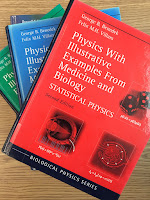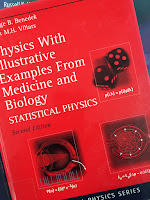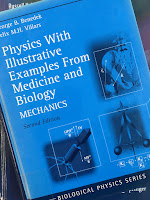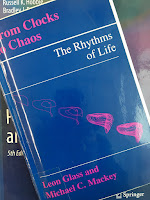I’m obsessed with citations. I realize citation analysis has its limits, but it provides an objective way to measure the impact of a publication. Today I want to focus on several recent publications that have cited the textbook that
Russ Hobbie and I wrote, the 4th edition of
Intermediate Physics for Medicine and Biology (
IPMB).
Most citations to
IPMB appear in research articles published in scientific journals. Anna Longo, from the Università di Palermo in Italy, and her collaborators cite
IPMB as reference 4 in their article “
Discrimination of LINAC Photon and Sunlight Contributions in Watch Glass Analyzed by Means of Thermoluminescence” (
Nuclear Instruments and Methods in Physics Research Section B-Beam Interactions with Materials and Atoms, Volume 281, Pages 89–96, 2012).
In the last decades the risk of accidental radiological exposure or overexposure of population has increased, because of both incidents related to industrial and medical applications of ionizing radiations and incidents related to the transport or to the dismission of radioactive sources, but also because of criminal activities with use of radioactive material [1], [2] and [3]. Biological effects produced by ionizing radiation on humans are strictly related to the absorbed dose [4].
De Wael et al., from the University of Antwerp in Belgium (“
Use of Potentiometric Sensors To Study (Bio)molecular Interactions,”
Analytical Chemistry, Volume 84, Pages 4921–4927, 2012), write
A Bolzmann (Gibbs) type of statistical mechanics reasoning will
lead to the Nernst equation to calculate the developed potential.17
Reference 17 is to
IPMB, but it is to…forgive me, Russ!…the vastly inferior 3rd edition. (I’m joking, of course. The 4th edition of
IPMB is, to a first approximation, the 3rd edition with some extra homework problems and an additional chapter about ultrasound. I’ve loved every edition, but I’m only a coauthor on the 4th.)
Some authors are citing even earlier editions. The German team of Burkhard et al. (“
Spatial Heterogeneity of Autoinducer Regulation Systems,”
Sensors, Volume 12, Pages 4156–4171, 2012) cite the second edition of
IPMB, which came out in 1988.
The diffusion coefficients for AHL are well known; [33] gives 4.9 × 1010 m2/s, the relation between molecular mass and diffusion coefficient given in [34] yields for 3OC6HSL a diffusion
coefficient of 9 × 1010 m2/s. We choose the latter value.
IPMB is reference 34, and I am guessing they refer to Fig. 4.12 (using the 4th edition figure numbers), which plots the diffusion constant as a function of molecular weight. I’m glad they chose the latter value.
According to the Web of Science, an Indian team led by Sunny Nagpal cited
IPMB in “
A Review on Need and Importance of Impurity Profiling” (
Current Pharmaceutical Analysis, Volume 7, Pages 62–70, 2011). Unfortunately, the
Oakland University library does not have access to this article, and I haven’t gone to the extreme of ordering these articles through interlibrary loan (obsessions have their limits). I found several other articles I couldn’t access, some in foreign languages, that I will not mention here.
An Italian team led by Alberto Rainer cited our analysis of biomechanics in their
Annals of Biomedical Engineering article “
Load-Adaptive Scaffold Architecturing: A Bioinspired Approach to the Design of Porous Additively Manufactured Scaffolds with Optimized Mechanical Properties” (Volume 40, Pages 966–975, 2012).
IPMB is reference 11.
The line of action of the
force was defined as the line joining the center of the
head of the femur to the center of gravity of the lower
end of this bone. Further studies have demonstrated
the importance of taking into account forces exerted
by muscles on the femur head, especially for describing
single-limb stand.11
Some citations to
IPMB aren’t what I would expect. For instance, in his paper “
Within Subject Matter Eligibility-A Disease and a Cure” (
Southern California Law Review, Volume 84, Pages 387–466, 2011) Allen Yu writes
In general, natural laws can be written in many forms. The relation F = m X a can also be written in the form of conservation of momentum p = m X v, for example. E.g., Lasaga, supra note 63, at 232. See also Russell K. Hobbie and Bradley J. Roth, Intermediate Physics for Medicine and Biology 83–84 (4th ed. 2007) (discussing, as another example, how continuity equations in general can be written in both integral and differential forms).
They say that all publicity is good publicity, so I am happy for the citation, but I am not sure what motivated Mr. Yu to choose
IPMB rather than one of the other thousands of books he could have cited to make this very general point.
Sometimes citations can be a little annoying. For instance, Hsu and Hsu discuss the 4th edition of
IPMB in “
Physics Teaching in the Medical Schools of Taiwan” (
Kaohsiung Journal of Medical Sciences, Volume 28, Pages S33–S35, 2012).
The credit hours would determine the textbooks and the scope and depth of teaching. Moreover, because of the distinction between the medical education system in Taiwan and those in other countries like the USA, a suitable physics textbook for medical students in Taiwan has also been a long-term problem. For instance, Physics by Kane and Sternheim [2] with a broad introduction to physical applications in medicine could be too simple in content because of the lack of calculus. Intermediate Physics for Medicine and Biology by Hobbie [1] apparently contains a lot of material beyond the level of general physics. Other physics textbooks can also fail to include physical application in medicine, be at a level too basic or advanced in physical principles or compound factors, and might not be suitable for use in Taiwan.
I guess they consider us to be too advanced for Taiwanese medical students, which is surprising given that I consider our book to the at an intermediate level. I’ll ignore their omission of the second author in “Hobbie [1]”, but the use of the word “apparently” suggests that Hsu and Hsu haven’t actually looked at our book.
Vaz and Griffiths, from the University of West England (“
Parathyroid Imaging and Localization Using SPECT/CT: Initial Results,”
Journal of Nuclear Medicine and Technology, Volume 39, Pages 1–6, 2011), cite
IPMB multiple times, but it seems that we are just one of a group of texts they use to cover their bases. The 3rd edition of
IPMB is reference 25.
99mTc-sestamibi has yielded sensitivity rates of about
90% in primary hyperparathyroidism (1–3,15–28).
With this method, 900 MBq are administered intravenously,
and planar images are acquired at 15 min and at
1.0–3 h after injection. (1–3,15–28)…
Especially when combined with CT, SPECT
becomes particularly helpful for preoperative localization
of eutopic and ectopic parathyroid adenomas (1–3,15–28)...
Many surgeons routinely use ultrasound, radionuclide
parathyroid imaging, or both before surgery, and scintigraphy
is also useful for locating the adenoma during surgery
(1–3,15–28)…
Although the superior or inferior origin of a parathyroid
gland often can be determined by its location, an enlarged
gland may migrate and be seen in scintigraphic images at
the level of the thyroid gland (1–3,15–28).
The internet is changing the way physicists publish articles. The 2nd edition of
IPMB is cited in the paper “
Peculiarities of Brain’s Blood Flow: Role of Carbon Dioxide” by Alexander Gersten, which appeared in the preprint collection
arXiv, submitted in March 2011.
It seems however
that the physical and mathematical aspects of the global cerebral blood flow (CBF), or
average rCBF, were not sufficiently explored. Our main interest is use of physical
principles (Hobbie, 1988), physical and mathematical reasoning as well as means to
describe the main features of CBF in a simple way.
My collaborator and former PhD advisor,
John Wikswo, and his colleagues cited
IPMB as reference 3 in their recent review “
How Do Control-Based Approaches Enter into Biology?” (
Annual Reviews of Biomedical Engineering, Volume 13, Pages 369–396, 2011). Reference 1 is Guyton and Hall’s
Textbook of Medical Physiology; that’s pretty good company.
For example, in whole-organ
physiology, control has been modeled in detail to provide a clear understanding of a multitude
of phenomena such as the control of blood oxygenation, pH and pressure, body temperature,
heart rate, hormone and glucose levels, neurohumeral feedback, pain adaptation, skeletal muscle
contraction, and visual object tracking (1–3).
Of course, I cite my own book (Roth, B. J., “
The Role of Magnetic Forces in Biology and Medicine,”
Experimental Biology and Medicine, Volume 236, Pages 132–137, 2011). In fact, I cite it in the opening paragraph of the paper (
IPMB is reference 1).
Over the last 20 years, several research groups have developed
imaging methods that take advantage of the force
acting on biocurrents when a magnetic field is present.
The underlying mechanism is familiar to anyone who has
taken an introductory physics class1: a wire carrying a
current I, having a length L and lying perpendicular to a
magnetic field B experiences a magnetic force F = ILB,
often called the “Lorentz force.”
Feel free to ignore this one, since self-citations really shouldn’t count. By the way, I discussed this paper in a
blog entry last year.
Not all citations are from journal articles.
IPMB is cited in Xiaogai Li’s doctoral thesis “
Finite Element and Neuroimaging Techniques to Improve Decision-Making in Clinical Neuroscience,” completed in 2012 at the Royal Institute of Technology in Stockholm.
The scalar proportionality
constant D is known as the diffusion coefficient and depends on the medium viscosity, the particle size and the temperature [68].
Reference 68 is
IPMB, and I expect the author refers to Eq. 4.23 in the 4th edition. A lot of these citations are to
IPMB’s discussion of diffusion. My guess is that there are few good books on this topic.
Bonginkosi Vincent Kheswa cited the very first edition of
IPMB in his masters thesis “
Deflection of Ag-atoms in an Inhomogeneous Magnetic Field” (Stellenbosch University, South Africa, 2011)
The γ-rays are high-energy photons that originate from transitions between the energy levels within the atomic nucleus [Ho78].
An odd reference to
IPMB appears in the journal
Computing in Science and Engineering (Volume 13, Pages 6–10, 2011), in Peter Jung's
review of the textbook
Introductory Biophysics by Claycomb and Tran (2010).
Furthermore, this
book [Claycomb and Tran] assumes that the reader has
already taken a course in calculus based
introductory physics; in that
respect, it’s unlike Russell K. Hobbie
and Bradley J. Roth’s Intermediate
Physics for Medicine and Biology,3
which assumes no knowledge of basic
physics.
The preface of our book states that “The reader is assumed to have taken physics and to know the basic vocabulary.” I expect a reader of
IPMB who had “no knowledge of basic physics” would struggle. But it’s nice to know that Jung believes our book is so clear that one could study from it with no prior exposure to physics.
Citations also appear in patents. Sawhney et al. cite
IPMB in US patent 8,003,705 (“
Biocompatible Hydrogels Made With Small Molecule Precursors,” 2011).
Visually observable visualization agents are preferred. Wavelengths of light from about 400 to 750 nm are observable to the human as colors (R. K. Hobbie, Intermediate Physics for Medicine and Biology, 2nd Ed., pages 371–373).
Other books sometimes cite
IPMB, such as
The SQUID as Diagnostic Tool in Medicine and its Use With Other Experimental Stimulation and Theoretical Methods for Evaluation and Treatment of Various Diseases by Photios Anninos of the Democritus University of Thrace in Alexandroupolis, Greece.
IPMB is reference 20, and refers to our analysis of Fourier series in Chapter 11.
In this Fourier statistical analysis each
MEG record it was stored for off-line statistical
analysis in which it was trying to find the best fit of
one trigonometric mathematical function [20] as it
is seen in the following equation:...
Another place to find citations are conference proceedings. Stiles et al. cite
IPMB at in the proceedings of the American Institute of Aeronautics and Astronautics (AIAA)
Gossamer Systems Forum, held April 4–7, 2011 in Denver, Colorado. Their paper “Voltage Requirements for Electrostatic Inflation of Gossamer Space Structures” refers to Eq. 6.10 and Fig. 6.10 in Section 6.3 about Gauss’s Law.
An approximation of the field at a
distance from a charged membrane can be made using the equation for the field due to a finite rectangular plate.30
Another example is “
Ascorbic Acid Encapsulation in Hydrophobic Silica Xerogel,” (Castro et al.,
Food Technology and Biotechnology, Volume 49, Pages 347–351, 2011) contained in the
Selected Papers Presented at the International Congress on Bioprocesses in Food Industries 2010, held October 5–8 in Curitiba, Brazil.
IPMB is reference 12. I’m guessing that the authors are referring to Section 5.9, A Continuum Model for Volume and Solute Transport in a Pore.
Taking into account the combined effect of xerogel porous radius r and of porous wall drag on the diffusion process (12), and using ~0.24 nm for the AA molecule mean radius and r~0.58 nm (from XRD results), another estimation of Deff is performed: Deff~6.2 × 10-7 cm2/s, which is 3.4 larger than the previous value.
What can we learn from all this?
IPMB shows up in all sorts of publications, often unexpectedly, and the citations are from scientists throughout the world. It is very gratifying that researchers choose to cite
Intermediate Physics for Medicine and Biology. Russ and I believe that our book makes a contribution to science and education, and it is good to know that others occasionally agree with us.











